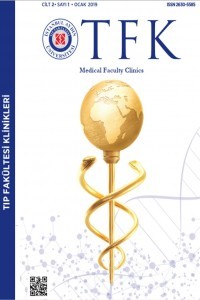SARS-CoV-2/COVID-19 Pandemisi
SARS-CoV-2, 2019-nCoV, COVID-19
___
- 1. Fehr AR, Perlman S. Coronaviruses: An overview of their replication and patho-genesis. Methods Mol Biol 2015; 1282: 1–23. 2. Li G, Fan Y, Lai Y et al. Coronavirus infections and immune responses. J Med Virol 2020; 92: 424– 32. 3. Cui J, Li F, Shi Z-L. Origin and evolution of pathogenic coronaviruses. Nat Rev Microbiol 2019; 17: 181-192. 4. Su S, Wong G, Shi W et al. Epidemiology, genetic recombination, and patho-genesis of coronaviruses. Trends Microbiol 2016; 24: 490-502. 5. Channappanavar R, Perlman S. Pathogenic human coronavirus infections: causes and consequences of cytokine storm and immunopathology. Semin Immunopathol 2017; 39: 529-539. 6. Drosten C, Günther S, Preiser W et al. Identification of a novel coron- avirus in patients with severe acute respiratory syndrome. N Engl J Med 2003; 348: 1967-1976. 7. Ksiazek TG, Erdman D, Goldsmith CS et al. A novel coronavirus associated with severe acute respiratory syndrome. N Engl J Med 2003; 348: 1953-1966. 8. WHO. Middle east respiratory syndrome coronavirus (MERS-CoV). 2020. 9. Chan JF-W, Kok K-H, Zhu Z et al. Genomic characterization of the 2019 novel humanpathogenic coronavirus isolated from a patient with atypical pneumonia after visiting Wuhan. Emerg Microbes Infect 2020; 9: 221-236. 10. Huang C, Wang Y, Li X et al. Clinical features of patients infected with 2019 novel coronavirus in Wuhan, China. Lancet 2020; 395: 497-506. 11. WHO. Novel Coronavirus (COVID-19) Situation. https://experience.arcgis.com/experience /685d0ace521648f8a5beeeee1b9125cd 12. Lu R, Zhao X, Li J et al. Genomic characterisation and epidemiology of 2019 novel coronavirus: implications for virus origins and receptor binding. Lancet 2020; 395: 565-574. 13. Paraskevis D, Kostaki EG, Magiorkinis G et al. Full-genome evolutionary analysis of the novel corona virus (2019-nCoV) rejects the hypothesis of emergence as a result of a recent recombination event. Infect Genet Evol 2020; 79: 104212. 14. Zhou P, Yang X-L, Wang X-G et al. A pneumonia outbreak associated with a new coronavirus of probable bat origin. Nature 2020; 579, 270-273. 15. Li Q, Guan X, Wu P et al. Early transmission dynamics in Wuhan, China, of novel coronavirusinfected pneumonia. N Engl J Med 2020; 382: 989- 998. 16. Wang D, Hu B, Hu C et al. Clinical characteristics of 138 hospitalized patients with 2019 novel coronavirus-infected pneumonia in Wuhan, China. JAMA 2020; E1-E9. doi:10.1001/jama.2020.1585 17. Chen N, Zhou M, Dong X et al. Epidemiological and clinical characteristics of 99 cases of 2019 novel coronavirus pneumonia in Wuhan, China: a descriptive study. Lancet 2020; 395: 507-513. 18. Zhang H, Kang Z, Gong H et al. The digestive system is a potential route of 2019-nCov infection: A bioinformatics analysis based on single-cell transcriptomes. BioRxiv 2020; 1-19. https://doi. org/10.1101/2020.01.30.927806. 19. Lu C-W, Liu X-F, Jia Z-F. 2019-nCoV transmission through the ocular surface must not be ignored. Lancet 2020; 395: e39. 20. Mahase E. China coronavirus: What do we know so far? BMJ 2020; 368: m308. 21. Wu JT, Leung K, Leung GM. Nowcasting and forecasting the potential domes- tic and international spread of the 2019-nCoV outbreak originating in Wuhan, China: A modelling study. Lancet 2020; 395: 689-697. 22. Guan WJ, Ni ZY, Hu Y et al. Clinical Characteristics of Coronavirus Disease 2019 in China. N Engl J Med 2020; 1-13. 23. Michael DC, Susan MP, Mona RL et al. Severe acute respiratory syndrome. Clin Infect Dis 2004; 38: 1407-1420. 24. World Health Organization, Novel Coronavirus (2019-nCoV) Advice for the Public. 2020. 25. Bespoke, Bebot Launches Free Coronavirus Information Bot. 2020. 26. Türkiye Cumhuriyeti Sağlık Bakanlığı Halk Sağlığı Genel Müdürlüğü. COVID-19 Algoritmalar. https://hsgm.saglik.gov.tr/tr/covid19-algoritmalar 27. Türkiye Cumhuriyeti Sağlık Bakanlığı Halk Sağlığı Genel Müdürlüğü. COVID-19 (SARSCoV2) Enfeksiyonu Rehberi. Bilim Kurulu Çalışması. https://hsgm.saglik.gov.tr/depo/covid19/ rehberler/COVID-19_RehberiV5-25Subat2020.pdf
- ISSN: 2630-5585
- Başlangıç: 2018
- Yayıncı: İstanbul Aydın Üniversitesi
Üniversiteli Sporcu Öğrencilerin Beslenme Destek Ürünleri Kullanım Durumu
Serap ANDAÇ ÖZTÜRK, İndrani KALKAN, Ceyda DURMAZ, Merve PEHLİVAN, Gökçen ÖZÜPEK, Zeynep Damla BAKMAZ
Ani İşitme Kaybı (AİK) Hastalarının Hemoreolojik Parametrelerinin İncelenmesi
Mukaddes SİNAN, Nesrin Zeynep ERTAN, Özlem YALÇIN, Bengüsu MİRASOĞLU
Fulya KÜÇÜKCANKURT, Nedret ALTIOK
Metformin İlişkili Laktik Asidoz; Bir Olgu Nedeni İle Literatürün Gözden Geçirilmesi
Bedih BALKAN, Güray DEMİR, Fevzi BALKAN, Halil ÇETİNGÖK, Erdal ATİÇ
